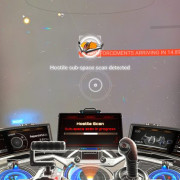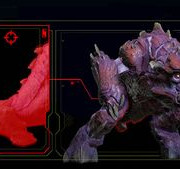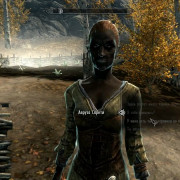Mobs
Содержание:
Materials
- Amate Paper: Used to make panes, books, and maps.
- Amulet Socket: Used in the creation of wearable amulets.
- Anadia Parts: Various parts obtained from trimming an Anadia, used in a variety of important recipes.
- Ancient Remnant: Used to make the Censer, and in the process of making a Draeton.
- Angler Tooth: Used to make arrows, or can be ground and used for their Aspects.
- Cremains: Used to make Pebbles and the Censer.
- Crimson Snail Shell: Can be ground and used for their Aspects.
- Dentrothyst Shards: Used to make full dentrothyst blocks and vials for Aspects and Infusions.
- Dragonfly Wing: Used to make arrows and feed Harlequin Toads.
- Dried Swamp Reed: Used to make thatch, donuts, and plant fertilizer.
- Dry Bark: Can be composted, ground, or used to make amate paper.
- Item Scroll: Special items that can be animated into a random rare item.
- Loot Scraps: Recycled loot items used to make Fabricated Scrolls for a chance at different loot.
- Lurker Skin: Used to make special armor, shields, and pouches.
- Middle Gems: Used to enhance equipment, or can be ground and used in making Infusions.
- Mud Brick: Used to make various Mud Brick blocks.
- Ochre Snail Shell: Can be ground and used for their Aspects.
- Octine Ingot: Used to make intermediate tools, shields, special arrows, and some utilities.
- Octine Nugget: Can be combined into a full Octine Ingot.
- Poison Gland: Used to make poison-tipped arrows.
- Reed Rope: Used as binding in a variety of important recipes.
- Rubber Ball: Used to make special boots and vials for Aspects and Infusions.
- Scabyst: Can be coated on equipment to temporarily stall Corrosion.
- Shambler Tongue: Used to make and upgrade Grappling Hooks.
- Slimy Bone: Used to make basic tools, armor, and shields.
- Sludge Ball: Can be cooked into jello or used to breed Mire Snails.
- Snot: Used to make Rocksnot Pods and produce eggs from Olms.
- Sulfur: An extremely important fuel source for the Betweenlands.
- Swamp Kelp: Can be replanted, fried, or ground and used in making Infusions.
- Swamp Reed: Can be replanted, dried, or made into Reed Rope.
- Syrmorite Ingot: Used to make intermediate armor, shields, buckets, and various other utilities.
- Syrmorite Nugget: Can be combined into a full Syrmorite Ingot.
- Tar Beast Heart: Can be animated and used to make helpful minions or a summoning item.
- Tar Drip: Can be applied to rowboats, or used to make Tar Beast Hearts and helpful minions.
- Undying Embers: Can be used in the process of making a Draeton or to tame Emberlings.
- Urchin Spike: Used to make an upgraded Fishing Spear.
- Valonite Shard: Used to make advanced tools, armor, and shields, as well as the Sickle.
- Valonite Splinter: Can be combined into a full Valonite Shard.
- Weedwood Bowl: Used for making various advanced food items.
- Weedwood Stick: Used as a basic material in a wide variety of recipes.
Lore
During the time when the light in The Overworld had just begun to shine and the flames of The Nether had just begun to burn, there existed a dimension which is little other than a void of nothingness. But out of nowhere, a giant inter-dimensional rift appeared and energy seeped into it, giving it potential for life to populate and grow in this dimension. A race of NPCs inhabited it, including a powerful Druid. He and his followers worked to twist the Nether’s evil into a weapon of peace. However, when they opened the portal in this dimension, evil surged out into it. This caused the NPCs to become Wights. The Druid himself became the Prime Wight, and he now wielded power over this dimension. He caused the Betweenlands to become a swampy, deathly land, as it is now. After much time, a traveler (the player) found their way to the dimension.
Compatibility
As the Betweenlands is run on Minecraft Forge, it is compatible with almost any other 1.12.2 forge mod. Notable incompatible mods or types of mods are shown below:
- Shader mods: If you are using outside shader mods with the Betweenlands mod, you may experience visual glitches and issues, as the Betweenlands uses its own custom shaders which conflict with outside shaders. This includes Optifine.
- Biomes o’ Plenty (or any other major biome mod, really): You may experience biome ID conflicts with the Betweenlands’s biomes. If this occurs, simply change the IDs in the mod’s config to unused IDs and you should be set.
History
- Release 3.4.0: Now appears on Amate Maps with an icon.
-
Release 3.3.9:
- Added config to create custom portals.
- Added config to specify unsafe biomes for the portal to avoid.
- Release 3.3.8: Added config for maximum portal link distance.
-
Release 3.3.7:
- Increased portal check radius.
- Portal linking maximum distance increased from 500 to 1500 blocks.
- Release 3.3.3: Added portal overlay.
- Release 3.3.2: Lone Tree Portals can now be created using the Swamp Talisman.
- Release 3.3.1: Portals can now be linked together using the Swamp Talisman.
- Release 3.3.0: Added Advancements.
- Beta 2.0.0: No longer uses Portal Tree Bark; now uses Portal Frame with normal bark on all sides for the main composition.
- Beta 1.0.0: Introduced.
History
-
Release 3.8.0:
- Betweenstone Pebbles now generate in Swamplands and Swamplands Clearing biomes.
- Bubbler Crabs now spawn in Swamplands biomes.
- Release 3.7.1: Shamblers now spawn in Swamplands biomes.
- Release 3.6.0: Chiromaw Greebling Riders (later renamed to Greebling Riders) now spawn in Swamplands biomes.
-
Release 3.4.0:
- Added Swamplands Clearing sub-biome.
- Can now be viewed from Amate Maps.
- Menhirs now generate in Swamplands biomes.
- Greeblings now spawn in Swamplands biomes.
-
Release 3.3.0:
- Added biome foliage colors.
- Nibbletwig Trees now generate in Swamplands biomes.
-
Beta 2.0.0:
- Added biome grass colors.
- Coarse Swamp Dirt now generates in place of regular Swamp Dirt in Swamplands biomes.
- Beta 1.0.2: Frogs and Harlequin Toads now spawn in Swamplands biomes.
- Beta 1.0.0: Introduced.
The Story of The Betweenlands
In the beginning, when the Overworld’s light was just beginning to shine and the eternal flames of the Nether had just begun to burn, a vast empty space lay between the two realms, floating within the Void.
Though it was dark and lifeless, wisps of raw energy that remained from the dawn of time flowed here, thus giving it the potential to expand into a complete, self-contained dimension.
All it needed was the smallest spark of life.
By some strange cosmic coincidence, something extraordinary happened.
As the fabric of reality shifted, a thin, narrow crack appeared high up in the sky above the Overworld.
This crack was an interdimensional rift between the realms of Minecraftia, acting as a doorway to the long-empty space that lay between.
Lifeforce surged through the rift from the Overworld and planted the seed of creation on the other side.
The Betweenlands was born.
As time passed, creatures evolved into a race of NPCs which inhabited the young dimension.
These people were strong, proud and hard-working.
Over many centuries they built up a vast and mighty civilization.
Though these people were kind and caring at heart, they all shared a tremendous lust for power, in particular the ability to wield great magic.
This flaw would eventually become the catalyst of their demise.
A wise and powerful Sorcerer rose to power, who was fluent in the language of magic, Java.
The Sorcerer believed that if they could harness the dark forces of the Nether, they would be able to use the power as a tool of creation.
The Sorcerer and their followers worked tirelessly to conjure up the elements required to open up a portal from their world to the fiery pits of the Nether.
Eventually, the time came to light the frame of Obsidian.
Little did they know, it would destroy their world.
As soon as the portal had been opened, a great evil swept across the land from the portal like blood from a wound.
One by one, the people of the Betweenlands were transformed into Wights; beings of pure hatred, neither living nor dead.
The darkness consumed all.
Once the surge of dark energy had subsided, the once-great Sorcerer opened their eyes.
But they did not breathe, for they were no longer truly living.
They too had become a Wight, their mind, body and soul corrupted.
Their head hung low, with a sad, mournful expression playing across their face.
But they did not feel grief… they did not feel anything at all any more.
Only burning malice within.
The Sorcerer had become the Prime Wight, with an army of Wights to serve and do their bidding.
They had got just what they had wanted; they now wielded unimaginable power.
Meanwhile, in the Overworld, this activity had not gone without notice.
A small covenant of Druids attempted to heal the wounds left behind, but upon being exposed to this power, slowly became insane.
It seemed that all was lost until after many long years, a remarkable individual decided they needed to step in.
This brave young soul went by the name of (player name) and was well known for creating amazing architectural designs and redstone contraptions.
They valiantly defeated the powerful Dark Druids, and took possession of the uncompleted Talisman, a magical tool needed to open a portal to The Betweenlands.
Using an altar, a device keyed into the energies of the Betweenlands, the Talisman was carefully assembled and what the Druids has originally set out to do was finally completed.
The portal, was opened.
(player name) met and befriended the many nomadic tribes of the land, and agreed to help them in exchange for the ancient relics needed to bypass the defenses and travel to the Prime Wight’s Domain.
There, they would face the beast itself alone, and free the land of its terrible curse.
(player name) dropped down into the dark depths below, unknowing of what they would find.
The battle was long and hard, and the Wight’s dark energies took its toll on the (player name).
Despite this, they remarkably pulled through, and the tyrant was dead.
Hundreds of thousands of years of pain and suffering was over at last.
The blanket of shade was lifted, and light shone upon the forgotten realm once more.
The Wights were forced back down to the fiery pits from whence they came, deep down in the Nether.
The people of The Betweenlands were overjoyed, and celebrated in their saviour’s name.
A great festival was created in their honour, and is held once every year on the (current date).
The name of that bold adventurer will be passed down through generations, undying, never forgotten…
(player name), you have saved the world.
Behavior
Wights wander around slowly and cause visual distortion of the area around them. When they notice the player they will look up, mouths agape, and attack on sight with melee. They have a detection range of 80 blocks.
Wights have a chance to spawn applied with a random Amulet, which will give it Middle Gem Circle benefits depending on the type applied. This amulet will not drop upon their death.
If a Wight contacts Tar, it will transform into a Tar Beast after a few seconds.
Possession
Wights will occasionally transform into a disembodied head that is able to fly, pass through blocks, and «possess» players or Swamp Hags by grabbing onto their head, circling it as it does so. Wights are more likely to transform at lower health and when other Wights are nearby, but will not transform to chase the player unless hit by them. Once the Wight possesses an entity, it will begin to shoot homing particles outward, dealing magic damage that bypasses armor to the player as well as other nearby entities (excluding hostile Betweenlands entities.) The Wight’s hitbox completely surrounds the player’s head, meaning most of the player’s attacks can only hit the Wight. The Wight is still vulnerable to damage and can be removed after enough attacks, if it is not killed in doing so.
When a Wight possesses a Swamp Hag, it will not damage its host, and will continuously emit projectiles at the player until either it or the Swamp Hag are killed. It can be attacked separately from the mob it is possessing.
Aggressive Mobs
- Angler: A vicious flesh-eating fish that swims around in the waters of the Betweenlands.
- Ash Sprite: Sentient, floating remains that occasionally come out of broken alcove urns.
- Blood Snail: An aggressive snail that can squirt blood-red poison at its enemies.
- Boulder Sprite: A living boulder that hides underground and rolls into unsuspecting players.
- Bubbler Crab: A sneaky crustacean that produces popping bubbles before scuttling out of reach.
- Cave Jellyfish: A type of jellyfish found in the Lake Cavern waters that attacks with electric shocks.
- Chiromaw: A hungry bat-like creature that can be found hanging off the roofs of caverns.
- Crypt Crawler: A large, intelligent mole rat that resides in the crypts of the Sludgeon.
- Dark Druid: An insane Druid who chants around a druid altar in the Overworld swamps.
- Emberling Shaman: An Emberling that guards the Sludgeon Tower and wields fiery magic.
- Infestation: A swarm of tiny, bity bugs that will crawl all over your screen.
- Lamprey: A worm-like creature that emerges from the Sludgeon walls to suck in and decay the player.
- Large Sludge Worm: A giant, disgusting skeletal worm that emerges from the Pit of the Sludgeon.
- Leech: A lowly worm that sucks the blood of other living things.
- Living Root: A sentient root that emerges from the Sludgeon walls to strike the player.
- Peat Mummy: An undead skeleton that rises up from the peat and mud to attack the player.
- Rock Snot: An underwater, gaping-mouthed mollusk that snatches prey with its hook.
- Shallowbreath: A cloud of sentient fumes that chokes the life out of nearby players.
- Shambler: A shambling monstrosity that can use its long tongue to snatch the player.
- Silt Crab: An annoying crustacean that bites the toes of passersby before scuttling out of reach.
- Sludge: A blob of living goop that lies in wait for prey in the sludge plains.
- Small Sludge Worm: A medium-sized worm that emerges from holes it digs through the Sludgeon.
- Smol Sludge: A miniature blob of goop that hops about in the sludge plains.
- Stalker: An elusive creature that stalks the caverns, waiting for just the right moment to strike.
- Swamp Hag: A common undead creature that wanders throughout the Betweenlands.
- Tar Beast: A hulking monster made out of tar that resides in tar pits.
- Termite: A pesky insect that occasionally come out of broken rotten logs, pots and urns.
- Tiny Sludge Worm: A tiny, young worm that emerges from egg sacs in the Sludgeon.
- Wight: A twisted, spirit-like entity that looks sad on the outside, but lashes out if taken too lightly.
Properties
Farming
Spores can be planted in Dug Swamp Grass, Dug Swamp Dirt, Dug Purified Swamp Dirt, or Dug Purified Swamp Grass that has been fertilized with Compost. The spores grow into a Yellow Dotted Fungus crop that will produce edible Yellow Dotted Fungus.
Yellow Dotted Fungus crops will grow over time until ready to be harvested. Its growth can be augmented with Ground Dried Swamp Reed. When harvested at full maturity, the crop will drop Yellow Dotted Fungus and more Spores.
However, a Yellow Dotted Fungus crop’s growth will halt if the composted block it is growing on become decayed. If the crop is mature when this happens, it will decay as well, dropping nothing but Spores and detaching the fungus part of the crop as a live Sporeling.
Other Items
| Result | Ingredients | Recipe |
|---|---|---|
| Amulet (empty) | Reed Rope (5) + Amulet Socket | |
| Applies corresponding Middle Gem to Amulet | Amulet (empty) + Any Middle Gem | |
| Caving Rope (16) | Climbing Rope (8) + Bulb-Capped Mushrooms | |
| Compost (9) | Block of Compost | |
| Draeton | Draeton Balloon (3) + Reed Rope (2) + Syrmorite Ingot (2) + Any Weedwood Rowboat + Draeton Burner | |
| Draeton Anchor Upgrade | Syrmorite Ingot (3) + Reed Rope + Grappling Hook | |
| Draeton Balloon | Rubber Ball (5) + Lurker Skin (3) | |
| Draeton Burner | Ancient Remnant (5) + Undying Embers + Censer | |
| Draeton Crafting Upgrade | Weedwood Plank Slab (2) + Weedwood Stick (2) + Octine Ingot + Weedwood Crafting Table | |
| Draeton Furnace Upgrade | Weedwood Plank Slab (2) + Weedwood Stick (2) + Syrmorite Ingot + Sulfur Furnace | |
| Empty Amate Map | Any Middle Gem + Amate Paper (8) | |
| Grappling Hook | Shambler Tongue (2) + Angler Tooth (4) + Slimy Bone | |
| Upgrades Grappling Hook with additional segment | Angler Tooth (2) + Shambler Tongue + Grappling Hook | |
| Inanimate Angry Pebble | Cremains + Sulfur + Betweenstone Button + Betweenstone | |
| Large Gallery Frame | Small Gallery Frame (4) | |
| Charges Life Crystal (12-13% per heart) | Uncharged Life Crystal + Wight’s Heart (1-8) | |
| Lurker Skin Patch (3) | Tar Drip + Lurker Skin | |
| Lurker Skin Pouch (9 slots) | Lurker Skin (5) + Reed Rope (3) | |
| Upgrades Lurker Skin Pouch with 9 extra slots | Lurker Skin Pouch + Lurker Skin (8) | |
| Mummy Bait | Aspect Vial — Armaniis (1.0) + Animated Tar Beast Heart + Shimmerstone + Sludge Ball | |
| Plant Tonic | Any Bucket (Swamp Water) + Ball of Sap | |
| Small Gallery Frame | Weedwood Stick (8) + Lurker Skin | |
| Swamp Talisman | Moss or Moss (item) or Cave Moss or Cave Moss (item) + Slimy Bone + Life Crystal | |
| Tarminion | Tar Drip (8) + Animated Tar Beast Heart | |
| Very Large Gallery Frame | Large Gallery Frame (4) | |
| Volarkite | Volarpad or Volarpad Leaf (3) + Reed Rope (2) + Weedwood Stick (2) | |
| Weedwood Rowboat | Weedwood Planks (5) | |
| Weedwood Rowboat Lantern Upgrade | Weedwood Plank Slab (3) + Reed Rope (2) + Firefly (item) + Weedwood Planks (3) |
Pit of Decay
The Pit of Decay is the final room of the Sludgeon, and is also the room where the player can fight the Sludge Menace.
When they reach the bottom of the Sludgeon, the player will encounter a large mechanism suspended by chains, protected by flying shields, with a big, spinning gear shaped platform below it that will spin the player if stood on. In the middle of the gear is a big hole that continuously spawns Leech, Termites, Smoll Sludges, and Large Sludge Worms. On each side of the room are balconies, and below that, a wall made of Spike Traps. On each balcony there are two Sludge Jet Turrets that continuously respawn on either end, and lenses in the middle that shoot out a chain-shaped beam into the mechanism’s lenses.
To fight the boss, the player needs to drop the mechanism into the gear pit, which can be done by firing arrows at lenses on the mechanism, between the moving shields.
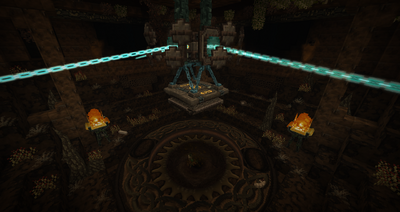
The first phase of the fight. (before)
Once a lens is struck, the chain beam will disappear. When all four sides are done, the mechanism will lower itself, all beams reactivating. The platform will slowly rise again, rising up significantly if the player strikes one of its shields. The player must repeat this process continuously, faster than the mechanism can raise itself, to drop it into the pit.
If a shield is hit, there is also a chance to spawn a «chain grabber» that will hold the player in place. The player can free themselves by rapidly pressing their attack button on it, or by shield charging with a Valonite Shield.
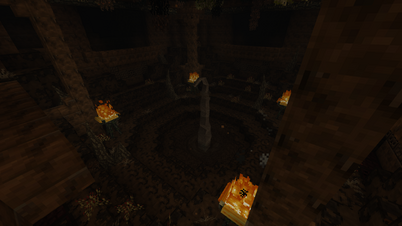
the second phase of the fight. (after)
Once the player has dropped the device five stages, the machine will fall onto the ground, plugging the pit and destroying the gears around it. After a short period of time, the ground will start to shake, and the Sludge Menace will rise from the depths of the ground as the final fight. (For more details and tips on the fight, see Sludge Menace)
Defeating the Sludge Menace will complete the dungeon and remove the block protection over the entire Sludgeon. This will also remove the Moving Walls and stop Sludgeon mobs from spawning.
Natural Blocks
| Result | Ingredients | Recipe |
|---|---|---|
| Bulb-Capped Mushroom Cap (4) | Bulb-Capped Mushrooms (4) | |
| Coarse Swamp Dirt (2) | Swamp Dirt + Silt | |
| Compacted Mud | Mud (4) | |
| Green Dentrothyst | Green Dentrothyst Shard (4) | |
| Corresponding Hearthgrove Log (4) | Matching Hearthgrove Log (4) | |
| Corresponding Nibbletwig Log (4) | Matching Nibbletwig Log (4) | |
| Orange Dentrothyst | Orange Dentrothyst Shard (4) | |
| Corresponding Sap Tree Log (4) | Matching Sap Tree Log (4) | |
| Corresponding Tarred Hearthgrove Log (1-8) (empty bucket is left behind) | Matching Hearthgrove Log (1-8) + Any Bucket (Tar) | |
| Corresponding Tarred Hearthgrove Log (4) | Matching Tarred Hearthgrove Log (4) | |
| Corresponding Weedwood Log (4) | Matching Weedwood Log (4) |
Properties
Farming
White Pear Seeds can be planted in Dug Swamp Grass, Dug Swamp Dirt, Dug Purified Swamp Dirt, or Dug Purified Swamp Grass that has been fertilized with Compost. The seeds grow into a White Pear Plant crop that will produce edible White Pears.
A White Pear Plant will grow over time until ready to be harvested. Its growth can be augmented with Ground Dried Swamp Reed. When harvested at full maturity, the bush will drop White Pears and more seeds.
However, a White Pear Plant’s growth will halt if the composted block it is growing on becomes decayed. If the plant is mature when this happens, it will decay as well, dropping nothing but seeds.
Drops
The drops from Wights are derived from the loot table.
The following is a list of all of the items that can be dropped by Wights, including their rolls, quantities, and weights.
| Wight Drops | ||
|---|---|---|
| Dropped Item | Quantity | Weight |
| 1 Roll, if killed by player: | ||
| Nothing | N/A | 2/3 (66.67%) |
| Wight’s Heart | 1(+0-1 per Looting level) | 1/3 (33.33%) |
| 2 Rolls, if killed by player, Spook event only: | ||
| Nothing | N/A | 1/4 (25%) |
| Blue Candy | 1 | 1/4 (25%) |
| Red Candy | 1 | 1/4 (25%) |
| Yellow Candy | 1 | 1/4 (25%) |
| 1 Roll, if killed by player, Winter event only: | ||
| Nothing | N/A | 1/2 (50%) |
| Mince Pie | 1 | 1/2 (50%) |
Visit the Loot Tables page for more information on loot.
Secret Rooms
There are a couple of secret rooms that can be found in the Wight Fortress. The details on finding them are hidden below in a spoiler tab; DO NOT open this tab if you do not wish to be spoiled.
| Secret Rooms (WARNING: SPOILERS) | |
|---|---|
| Secret Room | Picture |
| On the first floor, there is a back wall in the center room that appears to be made out of Betweenstone Bricks instead of the usual Betweenstone. There are two hidden entryways here concealed by Betweenstone Bricks Mirages, which can be passed through as if they were air. Behind these mirages is a small hidden room containing a double Weedwood Chest. | |
| The Stagnant Water pool in the center of the first floor can be jumped in, leading down into a hidden undercroft/basement room. A player going down here should eat Weeping Blue Pedals or a Weeping Blue Petal Salad to counteract the decay caused by the stagnant water. This room contains Pots as well as blocks of precious materials in its four corners, specifically Blocks of Octine, Syrmorite, and Valonite. There can also be Monster Spawners in these corners that spawn Swamp Hags. Note that jumping into the Stagnant Water to enter or leave the room generally means sacrificing your entire Decay meter. |
Custom Recipes
The Betweenlands adds a way for users to add recipes to the machines it adds. The compatible machines are: the Purifier, Mortar, Compost Bin, Animator, and Dark Druid Altar.
How each of these works can be found elsewhere. In your config folder there will be a folder called «thebetweenlands» and in this folder you have to create a file called recipes.json. To add recipes, you need to edit this file and put some basic stuff in there. Before we go into the specifics, there are a few things that are easier said beforehand.
There are a few basic structures that most recipes use:
Item template:
//The item ID
"id": "domain:name",
//The metadata/damage. Optional - if not specified is 0 for outputs and 'any' for inputs
"meta": 42,
//The NBT. Make sure quotation marks ("") are escaped. Optional.
"nbt": "{Tag: \"Value\"}",
//Item stack size. Optional - 1 if not specified
"size": 16
Entity template:
//The entity ID
"id": "EntityID",
//The NBT. Make sure quotation marks ("") are escaped. Optional.
"nbt": "{Tag: \"Value\"}"
Now that those are explained, let’s get into the specifics.
Compost Bin recipes:
Adding compost recipes is quite easy. These recipes take an input (item and composting time), and an output (compost amount).
- Composting time defines the time it will take for an item to turn into compost. This number is in ticks (20 ticks = 1 second)
- Compost amount is the amount of compost it will create. The compost bin can hold a maximum of 100 compost and uses 20 to make a compost item.
Compost recipes can be added as follows:
"compost_bin": [
{
"input": {
"item": {
//Item template goes here
},
//Time it takes to turn into compost
"composting_time": 40
},
//How much compost is created
"output": 20
}
]
Mortar recipes:
Adding pestle and mortar recipes is easy. These recipes require only the basic tags: input (item) and output (item).
Mortar recipes can be added like this:
"pestle_and_mortar": [
{
"input": {
//Item template goes here
},
"output": {
//Item template goes here
}
}
]
Purifier recipes:
Adding purifier recipes is almost exactly the same as Mortar recipes:
"purifier": [
{
"input": {
//Item template goes here
},
"output": {
//Item template goes here
}
}
]
Animator recipes:
Adding animator recipes are a bit more complicated. These recipes require an input (item, fuel amount and life amount) and either one item output, an entity output or both.
Life amount and fuel amount are, respectively, the amount of Sulfur and amount of Life Crystal that will be consumed.
Adding a recipe with an entity as output works like this:
"animator": [
{
"input": {
"item": {
//Item template goes here
},
//Amount of fuel
"fuel": 8,
//Amount of life crystal
"life": 4
},
"output_entity": {
//Entity template goes here
},
//Specify which entity should be rendered. Optional.
"rendered_entity": "thebetweenlands.swamp_hag"
}
]
Adding a recipe with an item as output is almost the same:
"animator": [
{
"input": {
"item": {
//Item template goes here
},
//Amount of fuel
"fuel": 8,
//Amount of life crystal
"life": 4
},
"output": {
//Item template goes here
}
}
]
You can also specify both «output» and «output_entity» at once.
Animator reparing recipes (coming in version 3.3.0+):
Once version 3.3.0+ is released you will be able to add custom recipes for item repairing in the animator.
Life amount and fuel amount are, respectively, the amount of Sulfur and amount of Life Crystal that will be consumed.
The required amounts are linearly interpolated between the minimum and maximum amounts depending on how damaged the item is.
"animator_repairable": [
{
"input": {
"item": {
//Item template goes here
},
//Minumum amount of fuel required to repair the item
"min_fuel": 2,
//Mimumum amount of life crystal required to repair the item
"min_life": 4,
//Amount of fuel required to repair the item if it is fully broken
"max_fuel": 32,
//Amount of life crystal required to repair the item if it is fully broken
"max_life": 60
}
}
]
Dark Druid Altar recipes:
Adding druid altar recipes requires 4 inputs (item) and one output:
"druid_altar": [
{
"input": {
"item_1": {
//Item template goes here
},
"item_2": {
//Item template goes here
},
"item_3": {
//Item template goes here
},
"item_4": {
//Item template goes here
}
},
"output": {
//Item template goes here
}
}
]
Example file:
Here’s an example file that you can try out yourself:
{
"purifier": }}"
}
}
],
"animator": , CustomName:\"Weak Swamp Hag\", CustomNameVisible:1}"
},
"rendered_entity": "thebetweenlands:swamp_hag"
}
],
"animator_repairable": ,
"compost_bin": ,
"druid_altar": ,
"pestle_and_mortar":
}


